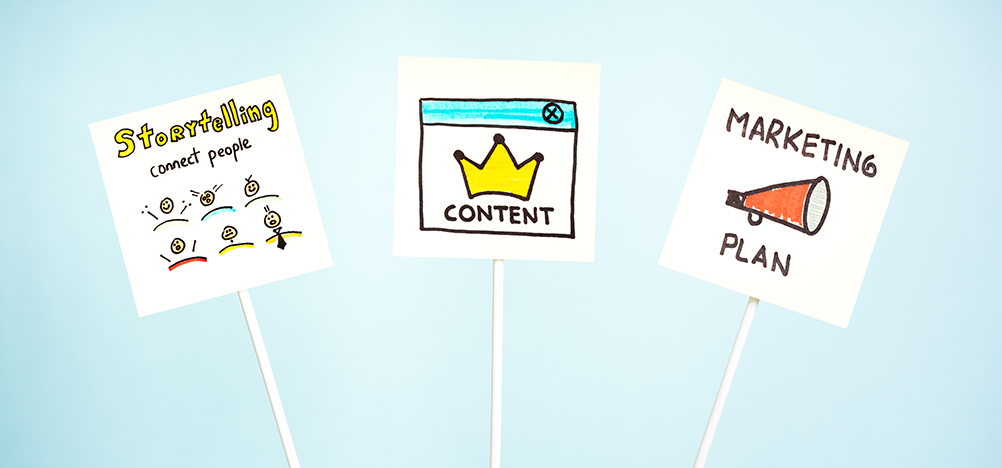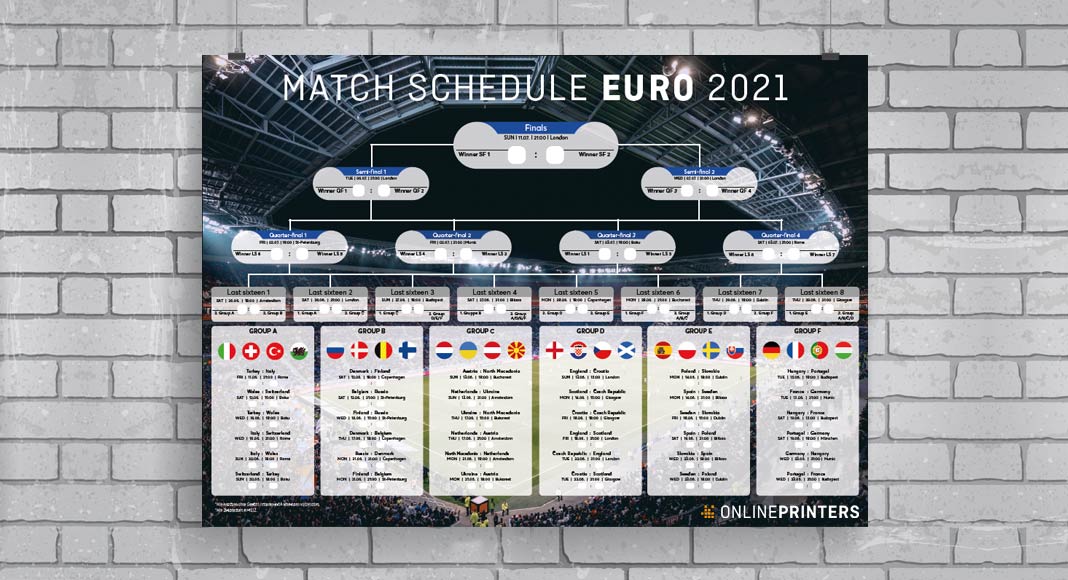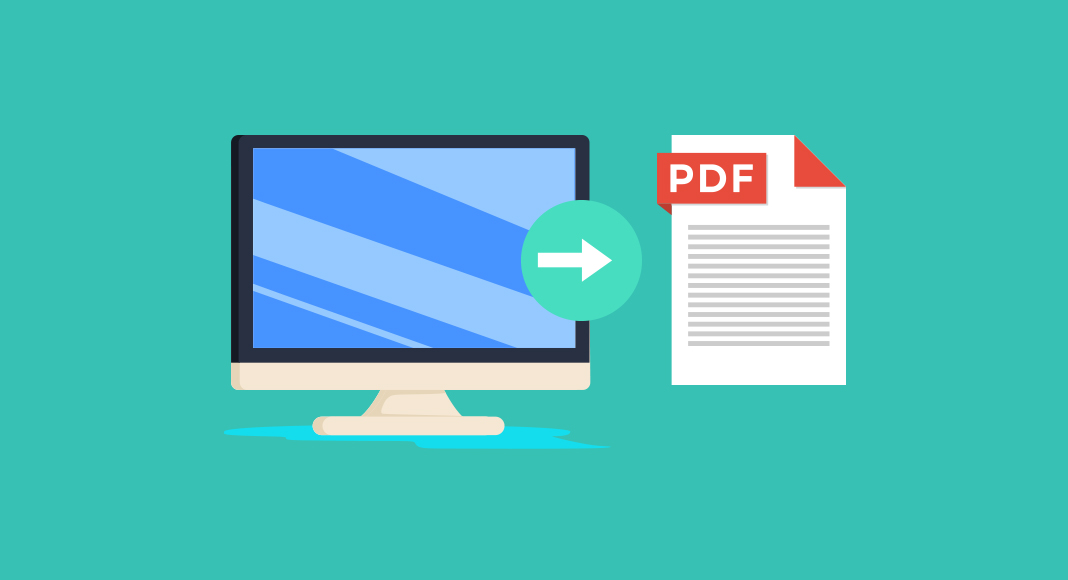Content Marketing has become indispensable but sometimes it’s just too much. Too much content that misses the mark overwhelms consumers and decision-makers. If you want to reach your target group, you have to create targeted content.
“Content is king” Microsoft founder Bill Gates wrote in a 1996 article promoting the internet as a marketplace for content. More than 20 years later, nobody needs to be reminded of this anymore. To the contrary, each marketing department has internalised this principle so that we are exposed to a real flood of content thanks to content marketing.
The consequence is clear: It has become increasingly difficult to reach target audiences since many content creators vie for the attention of users with texts, videos and images. In this article, we will present ways of meeting this challenge. But first of all: What exactly is content marketing?
Contents
- Content marketing – definition
- Why is content marketing so important?
- Content marketing in practice
- Implementing content marketing
- Creating targeted content
- >>> Content checklist
Content marketing – definition
“Content marketing especially in online marketing and here social media communication refers to the informative, instructional and/or entertaining provision of company information in customer communications with the aim of getting them to engage with the information in the first place and ideally triggering viral processes. Classic marketing communication for advertising purposes with the aim of getting consumers to make purchases as the central variable is presently considered unsuitable here. Content marketing as a key action area of Marketing 4.0 represents a methodical shift in marketing away from sales-oriented marketing communication toward public relations.”
Prof. Dr. Jan Lies in Gabler Wirtschaftslexikon
Broken down into its individual components, this means
- that content marketing provides company information to customers.
- This content can be informative, instructional and entertaining or all three. Or just two.
- The home of content marketing is primarily the online marketing sector. Added by us: Content marketing also includes adding content to printed company material, such as brochures, leaflets etc.
- Social media communication as a subdomain of online marketing has great significance in content marketing.
- Content marketing is a part of customer communications.
- The goal of content marketing is to get customers to engage with the company or the information provided and ideally share the content via the internet.
- Marketing 4.0 is a new direction that has been emerging since around 2010. It incorporates the latest technical possibilities and promotes customer centricity.
- This changes the nature of the content: Editorial/informative texts are requested, not advertising.
Why is content marketing so important?
Because everyone’s doing it to put it plainly. Of course, this is not a strong argument. The following reason is more convincing: Without content marketing, a company has little influence on the customer because customers usually make their purchase decision before they have had any form of contact with the company.
WITHOUT CONTENT MARKETING
YOU HAVE LITTLE INFLUENCE
ON CUSTOMERS
Before every major purchase or new order, potential customers inform themselves about eligible products, companies and offers. Failing to over helpful information will deter prospective clients.
Consequently, content marketing can be used to position your company as well as inform and entertain potential customers before they even have the intention to purchase (i.e. early on in the customer journey). When they finally need an offer, your customers will ideally remember your good content, the appealing offer or suitable product.

Content marketing in practice
How and where is content marketing used? It is used to drive (potential) customers to your company through content. The content can be purely informative as mentioned above, e.g. by explaining the latest trends relating to your product or service. Or you can provide hands-on instructions to customers.
Both types of content are met with more acceptance if they are presented in an entertaining way. Sometimes your content can be designed exclusively to entertain people. Using humour in your content can be a powerful thing. In any case, the content should provide added value to your customers. Where the content is published depends on the type and the overall content strategy.
Here are some examples of where content marketing is at home:
Printed and online
There are some measures you can implement both online and offline. Often, the same content can be used but in some cases the content has to be adapted to the respective medium and a slightly different target audience. Examples:
- technical articles
- direct mail marketing
- brochures
- customer magazines
- books/e-books
Online only
The internet provides fast and inexpensive ways to communicate your content to customers. Ideally, this content goes viral, i.e. it is spread continuously and greatly multiplies its reach. Possible platforms:
- (company) website
- newsletter
- social media
What content can look like
The content can be implement in many forms and scopes, from short snippets of information to detailed essays. Here is a selection of what is possible:
- post, tweets etc. about social media
- blog posts on your own homepage
- videos (homepage, social media, events)
- podcasts (homepage, social media)
- images
- infographics
- articles
- glossaries, dictionaries
- surveys/studies
- white papers
- games
- tests

Implementing content marketing
Given this wealth of possibilities, don’t forget what’s most important: the content. If the content is not right, it does not matter how you present it. Your content must be of high quality, suitable for the target audience and eye-catching. It may sound tricky but is easily manageable using a step-by-step approach:
Which goals do I want to achieve with content marketing?
These are usually the customer-specific marketing goals a company sets for itself: winning new customers, customer loyalty , increasing awareness and reach of the brand etc. If you are new to content marketing, it is wise to tackle a subdomain first.
Once the goal(s) have been set, it’s time for step two of your analysis
How do I reach my target audience(s)?

To be able to create suitable content, you have to know your target audience first. Maybe there is more than one target audience because your clientele is not homogeneous? This calls for a target group analysis – in two respects: Who is this target audience and what does it want?
Analysing your target audience
To start with, the target audience can be divided into two large groups: your existing customers and prospective customers. You have to define both groups as precisely as possible.
Existing customers
It is recommended to get an overall picture first: What is the age structure and consumer behaviour? Can your customers be broken into individual target audiences to address them more selectively?
You can use a regularly updated customer database to determine your customers’ needs and preferences. Or you could use analysis tools (like Google Analytics) to gain important insights into your target group. These tools take a close look at your customer base or the visitors of your website or online shops.
All employees with direct customer contact are also an invaluable source of information, especially those working in sales. The analysis should also take into account personal experiences of the sales staff that are not listed in the database. Using market research data can be another promising option.
New customers
If you want to attract new customers who are similar to your existing clientele, you can use the information gained with the above methods. However, to open up new target groups, you have to invest more effort.
For example, if your target group is mainly comprised of the age group between 35 and 65, you may want to target an audience under 30 years of age. To learn what makes these young people tick and what moves them, you can tap into market research for example. But in any case, it’s worth doing your own research as well. Surveys and studies are often available on the internet or special marketing media.
Classify your target group(s)
Most of the time, you want to address all customers of the company. In this case, you have to find content that fits most customers; special content may sometimes appeal to a specific subgroup. For this purpose, you have to know the different subgroups and classify them internally for example by:
- Age: You can either use attributes such as “younger”, “older” and “old” or age ranges, such as “14 to 20 year old”. You may want to launch a campaign that targets senior citizens in particular.
- Consumer behaviour: You will want to know who bought which quantity of a product and also when and for what occasion.
- Importance: You may want to address in particular premium customers that contribute significantly to your profits and regularly win new customers through recommendations.
- Gender: If, for example, men are under-represented among your customers for no good reason, you may want to include special content for them.
- Occupational groups: This classification is useful for companies that provide specialised offerings.
- Other criteria: Moreover, you can create targeted content, e.g. for families, consumers with small budgets, athletes etc.
Identify needs
Knowing your target audience inside out gives you a clear edge over your competitors. You have to know which content is requested by all customers or just some of them. Possible needs are: staying up to date on the latest news and developments, having difficult issues explained, getting important tips and tutorials or simply being entertained.
Creating targeted content
Once you have established an accurate analysis of your target audience and their needs, you have overcome the first obstacle. You know whether your customers prefer background information or practical advice. You can’t go wrong with a mixed offering in most cases.
How do I find suitable topics?
The selection of topics depends on the needs and preferences of the target audience. This is because content marketing is all about customer centricity. Consequently, the central question is: Which content provides customers added value?
THE CENTRAL QUESTION: WHICH CONTENT PROVIDES CUSTOMERS ADDED VALUE?
To answer this question, you can first tap into your internal sources. Basically, each department can contribute relevant content for customers. For example, the development department can write a background story about designing the latest product, purchasing can provide information about the sourcing of raw materials and how this guarantees top quality.
In the second step, you can browse the news. Breaking news and topics everyone is talking about are good approaches. They have to be filled with content in such manner that they provide your customers a benefit. When in doubt, ask colleagues who are close to the customer.
Example:

Company A produces accessories that are supplied to the manufacturing industry. The marketing department posts topics in the B2B blog that are relevant to decision-makers. It contains relevant news, such as a law amendment that affects medium-sized enterprises, the introduction of a new material that conducts heat with high efficiency and the focal topics of the next trade show plus additional information you won’t find anywhere else.
As a hands-on guide the blog includes an infographic illustrating a new switching system and a guideline to implement the new data privacy regulations in the manufacturing sector. It also provides entertaining elements, such as an image gallery that represents the company’s beginnings 30 years ago and a collection of bon mots from the last congress.
How should the texts be written?
The texts should use simple wording and be easy to read. To achieve this, you have to use both plain language and a clear structure:
- a heading that piques the reader’s interest
- an introduction that quickly gets to the point.
- body text that provides more information or explanations
- subheadings and other structuring elements for long texts.
- a suitable ending (e.g. containing a conclusion, outlook)
Here, too, the focus must be on the benefit for your customers: They want a quick grasp of what the article is about and recognise the added value in it. But to get your customers to read the post, you have to attract their attention first. You can achieve this by using eye-catching or slightly provocative headings. But they shouldn’t be too sensational. After all, the heading should convey in a nutshell what the text is about.
HEADINGS SHOULDN’T BE TOO SENSATIONAL
Ideally, each topic, whether for B2C or B2B customers, is also entertaining. This does not mean that every sentence needs to be witty. Rather it is all about writing clearly. An efficient and memorable way to achieve this is by telling stories within your content.
Content intended for web publishing should also take SEO aspects into account. This can yield promising results especially if you want to increase your reach and attract new customers. If potential customers look up a question or specific content on Google or Bing and get the answer on your website, they are one step closer to doing business with you.
How to create content?
This depends on the form and medium you choose for the respective content. Generally it can be said that pure text without any visual elements is harder to digest by readers. So in addition to creating vivid images in your reader’s mind you should incorporate real pictures.
A company blog, for example, should have a different picture for each post that identifies it. Given the flood of visual stimuli we are exposed to every day, some pictures will get more attention than others. You can go for:
- Extraordinary: The more unusual a picture, the more curious readers will be and the more traffic you will get (whether on the internet or in a leaflet). But you should always make sure the image is relevant for what you are writing about.
- Personal: There is nothing more exciting than other people. This also applies to the B2B sector. Your beautiful flyer will look even better in the hands of a pleased customer.
- Authentic: Sure that stock photo would be the perfect fit. But you should stay away from it if it is already widely used in publications of your industry. In this case, it’s better to utilise your own photos which should look professional but don’t have to be perfect. A picture that creates the impression of being taken in the middle of a real business situation increases credibility.
- Explanatory: Some content is easier to get across using images than long-winded sentences. This explains the great popularity of infographics which usually attract a lot of attention and are well received by readers if written professionally.
Podcasts and videos are also very popular. Podcasts don’t contain any visual elements but they are a good way to reach customers thanks to the human voice. Videos further boost attention due to the moving pictures and they often go viral. But don’t make the mistake of overdoing it. Instead use video content sparingly and only when it serves the intended purpose.

Which channels promise success?
Generally, channels that best fit the topics and target groups are the most promising. Consumers who spend a lot of time on the internet are often easiest to reach using online media. Conservative or older customers may be happy with a printed booklet, decision-makers with professional articles in the industry journal. So it pays off to know your customers’ behaviours.
If you are new to content marketing, start by populating your website. There are no material costs and less successful content can be removed at any time. A blog can also be used to test new topics with short texts.
If they receive positive feedback from users, you can expand the content and print it, too. Pay attention to which channels are particularly profitable for your business as you proceed. This enables you to tailor the content even more selectively.
When is the right time?

There is a right time for everything. In content marketing, it is determined by the up-to-datedness of the topics and the customer’s buying and decision-making process (keyword: customer journey).
This means a topic must still be up to date and relevant when you take it up, ideally before it has entered the mainstream. In the B2B sector, it’s already too late once the news has found its way into mainstream media. Consequently, technical articles and newsletters must always be kept up to date. You can also use foreign language content to extend your range to international markets.
The other timeline is very individual. It is about providing customers with relevant content at each stop along the customer journey. To start, customers need background information to get an overview, next practical instructions that present a solution and navigate them to your product.
The content checklist
- Does my content meet the needs of customers?
- Does my content stand out from my competitors?
- Is the language I use easy to understand?
- Does the content attract enough attention?
- Are important topics missing?
- Have I chosen the right channels?
- How can I further expand the content?
Sources:
Gabler Wirtschaftslexikon
Photo credits:
One Photo, Gonzalo Aragon, fotogestoeber, Rawpixel.com, mrmohock (via Shutterstock); Miguel Á. Padriñán, Cristian Dina (via Pexels)



